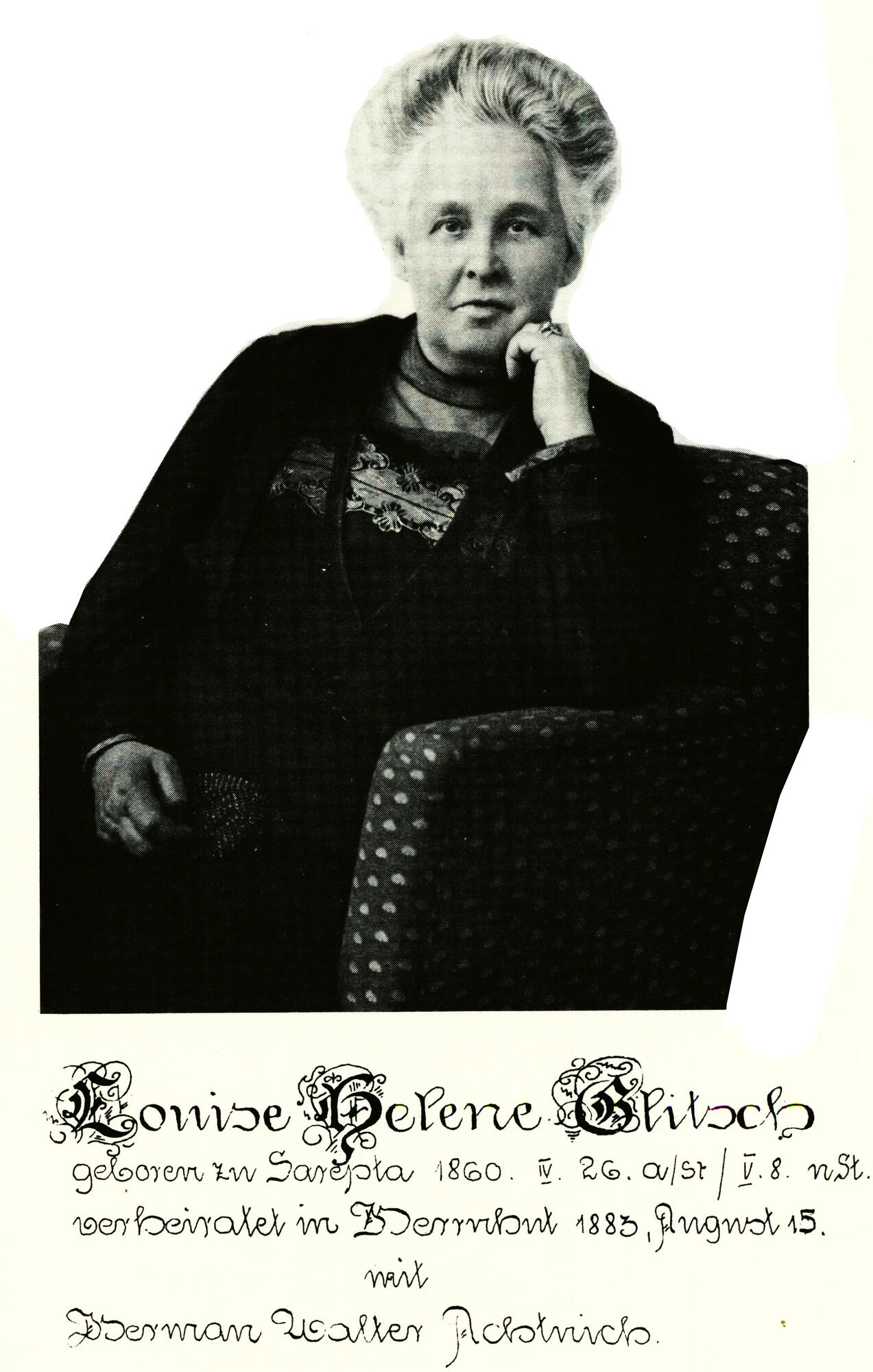This photo shows Louise Helen Akhtnich-Glitch, the representative of the richest and most influential family in the German colony of Sarepta.
Louise was born on May 8, 1860. She was the fourth child in the family of Ludwig Ferdinand and Adeline Glitch. Her father inherited the mustard production in Sarepta with his brothers and sister in 1852.
The colonists of Sarepta were the Hernguterrs - representatives of Protestantism. Since childhood, Louise was brought up in the best Hernguterr traditions, various biblical characters served as an example to follow. This was no coincidence: her uncle Alexander was the second preacher of the Sarepta community.
Louise Glitch’s memoirs are divided into two parts: “Church and Family Celebrations in Sarepta” and “The Gardens of Sarepta”. She wrote the first part in 1920 at the request of her eldest son, who wished to know how the holidays were celebrated in her distant homeland during her youth. This part is dedicated to her grandchildren.
“The Gardens of Sarepta” was written later, in 1928. Some features of this document are noteworthy. Unlike “Church and Family Holidays, ” these memoirs are clearly not written to order, although they are addressed to posterity. They are distinguished by their simplicity and sincerity. In these memoirs, Louise described the gardens that belonged to the Glitch family where she spent her childhood.
“The Gardens of Sarepta” consists of 14 sheets of original text and photographs in a modern archival cardboard binding. The first and last sheets of the document are made of heavy landscape paper. Photos are pasted on sheets. These handwritten memoirs were presented to the museum-reserve by the archivist H. Burkart from Königsfeld in 1997.
The second part of the memoirs, “Church and Family Holidays in Sarepta”, consists of handwritten calligraphic Gothic text, drawings, postcards and photographs of the late 19th - early 20th centuries. The text and illustrations were printed by facsimile in a printing house on white thick sheets of landscape paper. The first and last sheets are obviously the cover and contain no text or images. These documents were donated to the museum by Peter Glitch, the organist from Köngsfeld, one of the descendants of the large Sarepta family Glitch.
Louise was born on May 8, 1860. She was the fourth child in the family of Ludwig Ferdinand and Adeline Glitch. Her father inherited the mustard production in Sarepta with his brothers and sister in 1852.
The colonists of Sarepta were the Hernguterrs - representatives of Protestantism. Since childhood, Louise was brought up in the best Hernguterr traditions, various biblical characters served as an example to follow. This was no coincidence: her uncle Alexander was the second preacher of the Sarepta community.
Louise Glitch’s memoirs are divided into two parts: “Church and Family Celebrations in Sarepta” and “The Gardens of Sarepta”. She wrote the first part in 1920 at the request of her eldest son, who wished to know how the holidays were celebrated in her distant homeland during her youth. This part is dedicated to her grandchildren.
“The Gardens of Sarepta” was written later, in 1928. Some features of this document are noteworthy. Unlike “Church and Family Holidays, ” these memoirs are clearly not written to order, although they are addressed to posterity. They are distinguished by their simplicity and sincerity. In these memoirs, Louise described the gardens that belonged to the Glitch family where she spent her childhood.
“The Gardens of Sarepta” consists of 14 sheets of original text and photographs in a modern archival cardboard binding. The first and last sheets of the document are made of heavy landscape paper. Photos are pasted on sheets. These handwritten memoirs were presented to the museum-reserve by the archivist H. Burkart from Königsfeld in 1997.
The second part of the memoirs, “Church and Family Holidays in Sarepta”, consists of handwritten calligraphic Gothic text, drawings, postcards and photographs of the late 19th - early 20th centuries. The text and illustrations were printed by facsimile in a printing house on white thick sheets of landscape paper. The first and last sheets are obviously the cover and contain no text or images. These documents were donated to the museum by Peter Glitch, the organist from Köngsfeld, one of the descendants of the large Sarepta family Glitch.




